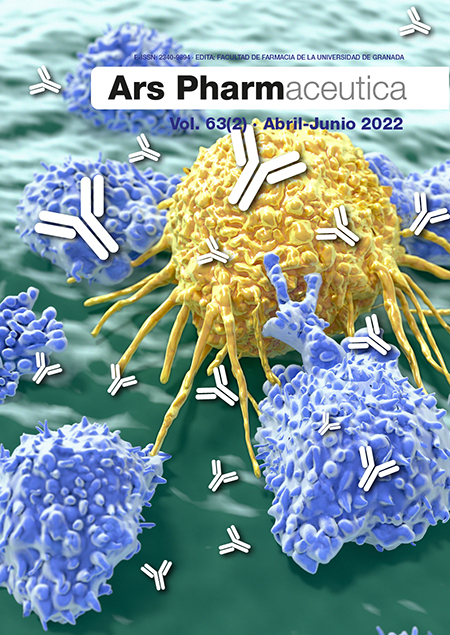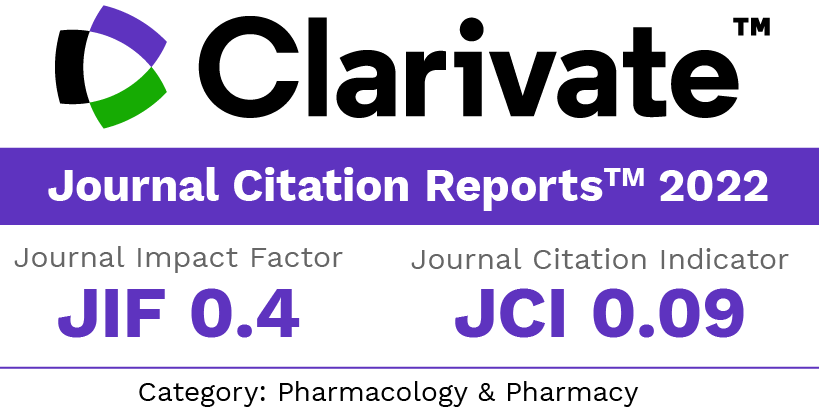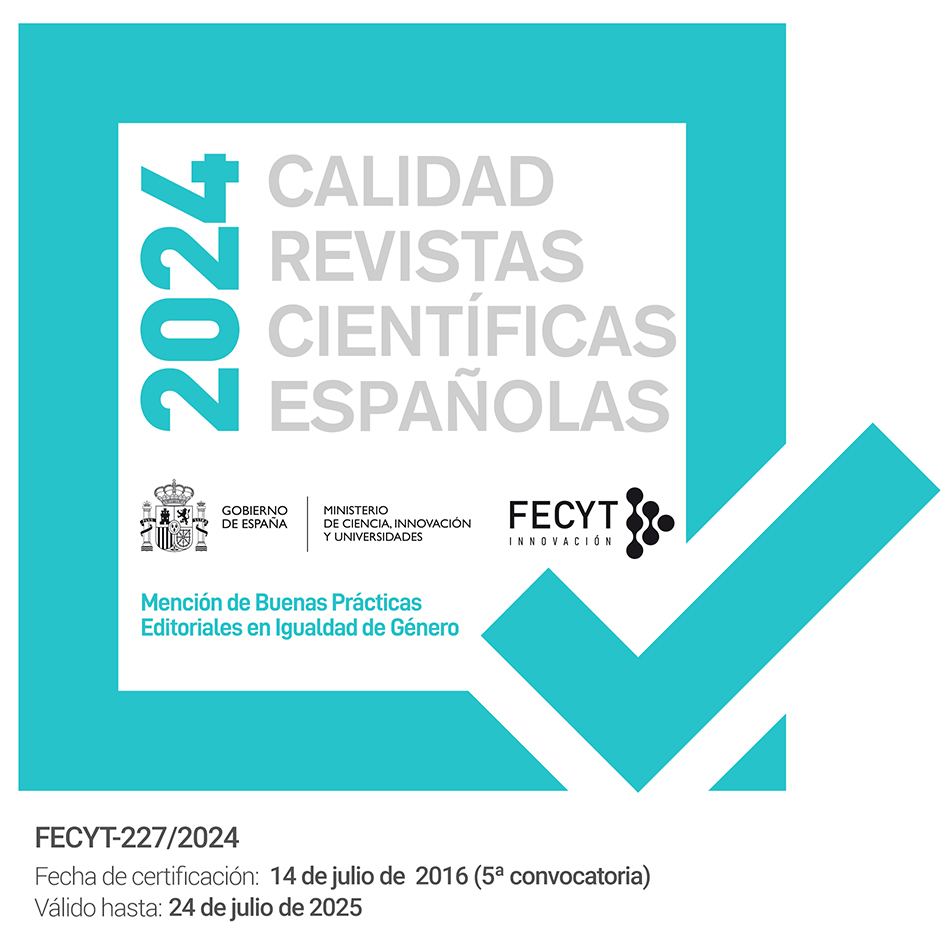Patient participation in research projects in Community Pharmacies: An exploratory study
DOI:
https://doi.org/10.30827/ars.v63i2.23641Keywords:
Patient participation, Community pharmacy, Research subjectsAbstract
Introduction: Over the last years there has been an increase in community pharmacy participation in research projects. Patient recruitment plays a key role in the research project success. Pharmacists’ barriers and enablers of recruitment have been identified, but little is known about the influence of research project-related factors. The aim of this paper is to explore patient participation in different studies conducted in community pharmacies and to identify study-specific factors that may be associated with it.
Method: An experimental multicenter study was performed in 12 community pharmacies participating in 4 research projects. The number of patients who accepted/refused to participate was recorded. Variables related to each offered study and the project were collected. A bivariate analysis using Pearson’s Chi-Square test and a risk analysis were performed.
Results: Participation rate was 90.44% (n=558). Study type (OR=2.64; 95%IC=1.47-4.75; cross-sectional vs pragmatic), the type of measurement applied (OR=2.47; 95%CI=1.43-4.36), the use of a personalized care area (PCA) (OR=2.49; 95%CI=1.44-4.39), and personal data request (OR=2.53; 95%CI=1.47-4.42) showed association with participation in the RP (p<0.05).
Conclusions: Patient participation in research projects is high and appears to rely on study-specific factors.
Downloads
References
Andrés Iglesias JC, Andrés Rodríguez NF, Fornos Pérez JA. Community pharmacy-based research in Spain (1995-2005): A bibliometric study. Pharm Pract Internet 2007;5:21–30. Doi: 10.4321/s1886-36552007000100004.
Saavedra-Mitjans M, Ferrand É, Garin N, Bussières J-F. Role and impact of pharmacists in Spain: a scoping review. Int J Clin Pharm 2018;40:1430–42. Doi: 10.1007/s11096-018-0740-7.
García-Cárdenas V, Gastelurrutia MA, Malet-Larrea A, Peiró T, Pérez-Escamilla B, Saez-Escamilla B, et al. AdherenciaMED Project: Design, impact assessment and implementation of a professional service for therapeutic adherence at the community pharmacy setting. Madrid: Consejo General de Colegios Oficiales de Farmacéuticos ; 2019 ISBN: 978-84-87089-12-1
Castillo D, Burgos F, Gascón MP. El papel de las farmacias comunitarias en el control de las enfermedades respiratorias. Archivos De Bronconeumología 2015;51:429–30. Doi: 10.1016/j.arbres.2015.06.003.
Melton BL, Lai Z. Review of community pharmacy services: what is being performed, and where are the opportunities for improvement? Integr Pharm Res Pract 2017;6:79–89. Doi: 10.2147/iprp.s107612.
Bertilsson E, Serhal S, Emmerton L, Bosnic-Anticevich S, Krass I, Bereznicki B, et al. Pharmacists experience of and perspectives about recruiting patients into a community pharmacy asthma service trial. Res Soc Administrative Pharm 2021;17:595–605. Doi: 10.1016/j.sapharm.2020.05.012.
Crilly P, Patel N, Ogunrinde A, Berko D, Kayyali R. Community Pharmacists’ Involvement in Research in the United Kingdom. Pharm 2017;5:48. Doi: 10.3390/pharmacy5030048.
Gastelurrutia MA, Benrimoj SIC, Castrillon CC, Amezua MJC de, Fernandez-Llimos F, Faus MJ. Facilitators for practice change in Spanish community pharmacy. Pharm World Sci 2009;31:32–9. Doi: 10.1007/s11096-008-9261-0.
Kypri K, Samaranayaka A, Connor J, Langley JD, Maclennan B. Non-response bias in a web-based health behaviour survey of New Zealand tertiary students. Prev Med 2011;53:274–7. Doi: 10.1016/j.ypmed.2011.07.017.
Madigan MP, Troisi R, Potischman N, Brogan D, Gammon MD, Malone KE, et al. Characteristics of respondents and non-respondents from a case-control study of breast cancer in younger women. Int J Epidemiol 2000;29:793–8. Doi: 10.1093/ije/29.5.793.
Arfken CL, Balon R. Declining Participation in Research Studies. Psychother Psychosom 2011;80:325–8. Doi: 10.1159/000324795.
Ross S, Grant A, Counsell C, Gillespie W, Russell I, Prescott R. Barriers to Participation in Randomised Controlled Trials A Systematic Review. J Clin Epidemiol 1999;52:1143–56. Doi: 10.1016/s0895-4356(99)00141-9.
Bower P, Brueton V, Gamble C, Treweek S, Smith CT, Young B, et al. Interventions to improve recruitment and retention in clinical trials: a survey and workshop to assess current practice and future priorities. Trials 2014;15:399. Doi: 10.1186/1745-6215-15-399.
Groth SW. Honorarium or coercion: use of incentives for participants in clinical research. J New York State Nurses’ Assoc n.d.;41:11–3; quiz 22.
Qudah B, Thakur T, Chewning B. Factors Influencing Patient Participation in Medication Counseling at the Community Pharmacy: A Systematic Review. Res Soc Administrative Pharm 2021;17:1863–76. Doi: 10.1016/j.sapharm.2021.03.005.
Macfarlane H, Maidment I. Recruiting people with severe mental illness through community pharmacies: real-world experiences from a UK study. Bmc Fam Pract 2020;21:172. Doi: 10.1186/s12875-020-01243-5.
Stewart D, Madden M, Dongen AV, Watson M, Morris S, Whittlesea C, et al. Process study within a pilot cluster randomised trial in community pharmacy: An exploration of pharmacist readiness for research. Res Soc Administrative Pharm 2021;17:1750–7. Doi: 10.1016/j.sapharm.2021.01.005.
Downloads
Published
How to Cite
Issue
Section
License
Copyright (c) 2022 Carlos Fuentes-Senise, Francisco Javier Ferreira Alfaya, Maria Elena Senise-Gómez, Yasmin Cura

This work is licensed under a Creative Commons Attribution-NonCommercial-ShareAlike 4.0 International License.
The articles, which are published in this journal, are subject to the following terms in relation to the rights of patrimonial or exploitation:
- The authors will keep their copyright and guarantee to the journal the right of first publication of their work, which will be distributed with a Creative Commons BY-NC-SA 4.0 license that allows third parties to reuse the work whenever its author, quote the original source and do not make commercial use of it.
b. The authors may adopt other non-exclusive licensing agreements for the distribution of the published version of the work (e.g., deposit it in an institutional telematic file or publish it in a monographic volume) provided that the original source of its publication is indicated.
c. Authors are allowed and advised to disseminate their work through the Internet (e.g. in institutional repositories or on their website) before and during the submission process, which can produce interesting exchanges and increase citations of the published work. (See The effect of open access).























